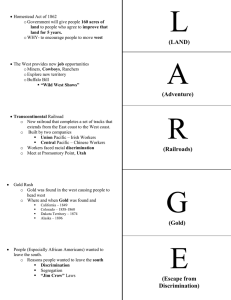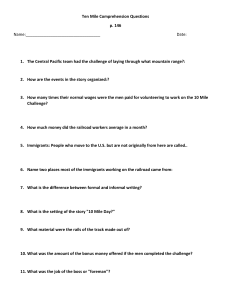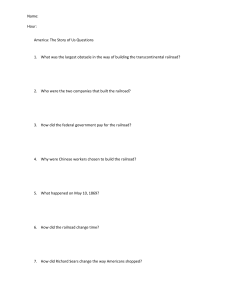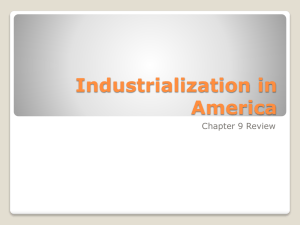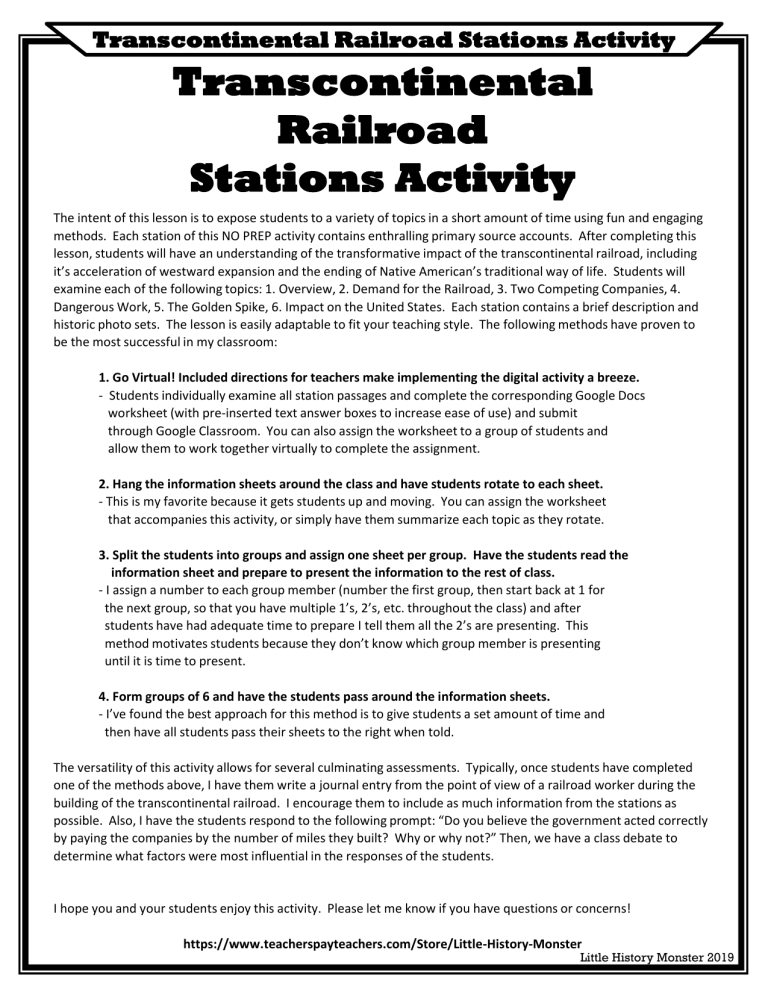
Transcontinental Railroad Stations Activity Transcontinental Railroad Stations Activity The intent of this lesson is to expose students to a variety of topics in a short amount of time using fun and engaging methods. Each station of this NO PREP activity contains enthralling primary source accounts. After completing this lesson, students will have an understanding of the transformative impact of the transcontinental railroad, including it’s acceleration of westward expansion and the ending of Native American’s traditional way of life. Students will examine each of the following topics: 1. Overview, 2. Demand for the Railroad, 3. Two Competing Companies, 4. Dangerous Work, 5. The Golden Spike, 6. Impact on the United States. Each station contains a brief description and historic photo sets. The lesson is easily adaptable to fit your teaching style. The following methods have proven to be the most successful in my classroom: 1. Go Virtual! Included directions for teachers make implementing the digital activity a breeze. - Students individually examine all station passages and complete the corresponding Google Docs worksheet (with pre-inserted text answer boxes to increase ease of use) and submit through Google Classroom. You can also assign the worksheet to a group of students and allow them to work together virtually to complete the assignment. 2. Hang the information sheets around the class and have students rotate to each sheet. - This is my favorite because it gets students up and moving. You can assign the worksheet that accompanies this activity, or simply have them summarize each topic as they rotate. 3. Split the students into groups and assign one sheet per group. Have the students read the information sheet and prepare to present the information to the rest of class. - I assign a number to each group member (number the first group, then start back at 1 for the next group, so that you have multiple 1’s, 2’s, etc. throughout the class) and after students have had adequate time to prepare I tell them all the 2’s are presenting. This method motivates students because they don’t know which group member is presenting until it is time to present. 4. Form groups of 6 and have the students pass around the information sheets. - I’ve found the best approach for this method is to give students a set amount of time and then have all students pass their sheets to the right when told. The versatility of this activity allows for several culminating assessments. Typically, once students have completed one of the methods above, I have them write a journal entry from the point of view of a railroad worker during the building of the transcontinental railroad. I encourage them to include as much information from the stations as possible. Also, I have the students respond to the following prompt: “Do you believe the government acted correctly by paying the companies by the number of miles they built? Why or why not?” Then, we have a class debate to determine what factors were most influential in the responses of the students. I hope you and your students enjoy this activity. Please let me know if you have questions or concerns! https://www.teacherspayteachers.com/Store/Little-History-Monster Little History Monster 2019 1. Overview The first American trains appeared during the 1830s. As American territories expanded westward, there was a growing desire for a railroad line to connect the sprawling railroad networks in the East, with the developing territories in the West. At the time, a journey from one coast to the other meant months of traveling by wagon across hostile terrain. The only other option was to travel by sea around South America, or to sail to Central America and cross the Isthmus of Panama by rail, risking exposure to numerous deadly diseases. In 1862, the Pacific Railroad Act authorized two companies – the Central Pacific and Union Pacific – to build a transcontinental railroad that would link the United States from East to West. The Central Pacific Company would start building in Sacramento, California and continue eastward across the Sierra Nevada Mountains. The Union Pacific Railroad would begin near the Iowa-Nebraska border, and build westward towards the West Coast. The two companies would join together in the middle, although there was no designated meeting point. Since each company was paid by the amount of track built, the job became a competition between the two companies. Each company faced numerous obstacles, such as bloody Native American attacks or dangerously blasting through mountains. Railroad workers faced various dangers and received low pay for their effort, causing each company to rely on immigrant workforces to complete the daunting work. After seven years the two companies met at Promontory Summit, Utah on May 10, 1869. The joining of the two railroads unified the country. The finished rail line made transportation faster and safer. Goods, supplies, and mail could be shipped more efficiently. The transcontinental railroad also facilitated westward expansion, escalating conflicts between Native American tribes and settlers. The overwhelming flood of people and resources into the West eventually led to the ending of traditional Native American way of life. Map of the Transcontinental Railroad - 1869 Source: “Transcontinental Railroad.” History.com, 20 Apr. 2010, https://www.history.com/topics/inventions/transcontinental-railroad. Little History Monster 2019 2. Demand for the Railroad Trains first appeared in America along the East Coast in the 1830s. By the 1840s, the nation’s railway networks extended throughout the East, South, and the Midwest. The idea of extending a railroad across the nation gained momentum, spurred by the annexation of the California territory following the Mexican-American War, and the discovery of gold in the West. Also, many Americans desired a quicker and safer journey across the continent. Before the transcontinental railroad, a trip across the continent meant a dangerous six month trek over rivers, deserts, and mountains while facing hostile Native Americans. The only other option for traveling from East Coast to West Coast was a hazardous sea voyage around South America, or to sail to Central America and cross the Isthmus of Panama by rail, risking exposure to numerous deadly diseases. Map showing coast to coast sea voyage Lobbying efforts during the 1850s aimed to gain federal funding for a railroad that would stretch across American, reaching the Pacific. Congress wouldn’t approve funding for the completion of the railroad, however they did approve numerous survey parties to investigate possible routes for a transcontinental railroad. In 1861, Theodore Judah, a civil engineer, supported the pleads for building a railroad across the nation by presenting his survey maps, which showed possible train routes through the West. With the Civil War raging, many Congressmen were hesitant about approving such an expensive project. Regardless, Abraham Lincoln signed the Pacific Railway Act on July 1, 1862, which authorized government land grants and bonds to two railroad companies, the Central Pacific Railroad and the Union Pacific Railroad. Map of East Coast railroad expansion by 1860 – lacking a connection to the West Source: “The Pacific Railway.” A Brief History of the Pacific Railway, https://railroad.lindahall.org/essays/brief-history.html. Little History Monster 2019 3. Two Competing Companies The Pacific Railroad Act authorized two railroad companies to complete the transcontinental railroad – the Central Pacific Railroad Company and the Union Pacific Railroad Company. The Central Pacific Company would start building in Sacramento, California and continue eastward across the Sierra Nevada Mountains. The Union Pacific Railroad would begin near the Iowa-Nebraska border, and build westward towards the West Coast. The bill required the two companies to meet in the middle, however an exact location was not designated. Since the government paid each company for every mile of track completed, and there was no designated meeting location for the two lines, the building of the transcontinental railroad was a competition between the two companies to lay the most miles of track, therefore gaining the most money. Advertisement posters for the finished railroad line - 1881 Both companies battled their respective obstacles to complete the job. Although the Central Pacific had a two-year head start over the Union Pacific, the rough terrain of the Sierra Nevada Mountains limited their construction to only 100 miles by the end of 1867. Once the Central Pacific passed through the Sierras, they moved at tremendous speed, crossing Nevada and reaching the Utah border in 1868. The Union Pacific faced fierce resistance from Native Americans who were witnessing their homelands invaded and way of life forever changed. Native American raiding parties attacked surveyors and workers, stole livestock and equipment, and pulled up track and derailed locomotives. Nevertheless, the Union Pacific raced westward through Wyoming, moving at an equal tempo with the Central Pacific. By early 1869, the Central Pacific and Union Pacific were closing in on each other across northern Utah. An end point had to be set for both sides. On April 9, 1869, Congress established the meeting point in an area known as Promontory Summit, located north of the Great Salt Lake; some 690 track-miles from Sacramento and 1,086 from Omaha. Map of the Transcontinental Railroad - 1869 Source: “The Pacific Railway.” A Brief History of the Pacific Railway, https://railroad.lindahall.org/essays/brief-history.html. Little History Monster 2019 4. Dangerous Work Finding and retaining workers proved to be challenging for both railroad companies. Labor was scarce during the Civil War. The Union Pacific primarily relied on Irish immigrants. Hiring workers became much easier for the Union Pacific following the Civil War, when tens of thousands of veterans were out of work. Hiring workers was more difficult for the Central Pacific. Initially, the company shipped workers from the East, at a great expense. But many of the men abandoned the railroad work, lured by the opportunity of striking it rich in gold or silver mines. Frustrated, the Central Pacific company began hiring Chinese workers. This was controversial at the time because the Chinese were considered poor workers due to pervasive racism. The Chinese laborers, however, proved to be tireless workers. Within a few years, 80 percent of the Central Pacific workforce was made up of Chinese workers, and they proved to be essential to the task of laying the railroad line through the Sierra Nevada Mountains. The Chinese laborers accomplished remarkable and dangerous feats no other workers would or could do. Chinese railroad workers a snow storm Maintaining a robust workforce was difficult – for good reason. Railroad workers faced abundant dangers and received low pay for their efforts. The Union Pacific suffered through bloody attacks from Native American tribes who were threatened by the invasion of the white man and his “iron horse” that threatened to alter their way of life. Native American raiding parties attacked surveyors and workers, stole livestock and equipment, and pulled up track and derailed locomotives. The Central Pacific workforce used extremely dangerous explosives to blast tunnels through solid granite mountains – sometimes progressing only a foot a day. The Chinese workers often lived in the tunnels as they worked their way through the solid granite, saving precious time and energy from entering and exiting the worksite each day. They were routinely lowered down sheer cliff faces in makeshift baskets on ropes to drill holes, fill them with explosives, light the fuse, then hope that their coworkers yanked them up as fast as possible to avoid the blast. Bridge constructions by the Union Pacific Source: “Transcontinental Railroad.” History.com, 20 Apr. 2010, https://www.history.com/topics/inventions/transcontinental-railroad. Little History Monster 2019 5. The Golden Spike By 1867, the Union Pacific had covered nearly four times as much ground as the Central Pacific. Once the Central Pacific broke through the mountains in late June, however, each company moved at about the same pace. In their race to get ahead, both companies sped towards Salt Lake City, cutting many corners, such as building sloppy bridges or sections of track that would have to be rebuilt later. By early 1869, the companies were nearing each other. It was decided that the companies would converge at Promontory Summit, Utah, located north of the Great Salt Lake. On May 10, 1869, the president of the Central Pacific hammed a solidgold spike (which was later replaced with a regular spike) into a predrilled hole in the rail. The tracks were joined as locomotives from the two railroads met nose-to-nose to signal the joining of the two lines. Telegraphers announced the completion of the railroad, as people celebrated across the country. With the Civil War fresh in their minds, people applauded this new symbol of national unity. The words that were engraved on the golden spike expressed their feelings: “May God continue the unity of our Country as the Railroad unites the two great Oceans of the world.” Official poster announcing the opening of the Union Pacific railroad Celebration of the two rail lines joining - 1869 Source: “The Pacific Railway.” A Brief History of the Pacific Railway, https://railroad.lindahall.org/essays/brief-history.html. Little History Monster 2019 6. Impact on the United States The completion of the transcontinental railroad had a tremendous impact on the United States. The railroad united the country, reducing the 3,000-mile journey across the nation from a matter of months to weeks. The accelerated trip vastly improved transportation, communication and the movement of goods and supplies within the United States. The transcontinental railroad also opened up the American West to more rapid development. Western resources were readily exported to Eastern markets and settlers were transported to the Western frontier. The railroad turned the frontier wilderness of the western territories into regions populated by EuropeanAmericans, enabling towns and businesses to increase all across the region. The flood of people and resources into the west intensified conflicts with Native Americans, effectively ending their traditional way of life. Central Pacific train rounding Cape Horn, California - 1880 Maps displaying the growth of railroads in America Source: “Transcontinental Railroad.” History.com, 20 Apr. 2010, https://www.history.com/topics/inventions/transcontinental-railroad. Little History Monster 2019

